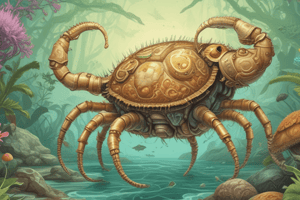Podcast
Questions and Answers
Which of the following are classes of annelids? (Select all that apply)
Which of the following are classes of annelids? (Select all that apply)
- Class Echinodermata
- Class Arthropoda
- Class Clitelatta (correct)
- Class Polychaeta (correct)
What percentage of annelid species does Class Polychaeta represent?
What percentage of annelid species does Class Polychaeta represent?
60%
Earthworms are classified under Class Polychaeta.
Earthworms are classified under Class Polychaeta.
False (B)
What is an example of a Polychaeta?
What is an example of a Polychaeta?
The term 'peripodium' refers to a '______ foot' structure found in annelids.
The term 'peripodium' refers to a '______ foot' structure found in annelids.
What are setae?
What are setae?
Flashcards are hidden until you start studying
Study Notes
Classes of Annelids
- Primary classes: Class Polychaeta and Class Clitellata.
Class Polychaeta
- Largest class within the annelids, comprising around 60% of all annelid species.
- Exclusively marine organisms inhabit deep seas or shallow waters.
- Many species are adapted to live in tubes constructed from sand or mud in ocean environments.
Subclass Oligochaeta
- This subclass includes free-living earthworms and is known for its soil-ingesting capabilities.
- Leeches were previously classified separately but are now included here as ectoparasites.
- Earthworms play a vital role in soil ecology by consuming organic material, including bacteria and spores.
Example of Polychaeta
- Nereis virens, commonly known as the clamworm, serves as a representative example of Polychaeta.
Peripodium
- Refers to the "side foot," a paired structure that enhances movement and stability.
Setae
- Defined as heavy bristles present on annelids, aiding in locomotion and anchoring in the substrate.
Studying That Suits You
Use AI to generate personalized quizzes and flashcards to suit your learning preferences.




